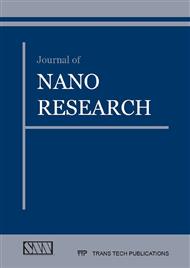p.1
p.13
p.20
p.28
p.36
p.42
p.51
p.58
p.68
Effect of Zirconia Nano Filler for Enhancing Energy Capacity in Polyethylene Oxide Based Polymer Electrolyte
Abstract:
Lithium ion batteries have become a popular power source for portable electronic equipments. It is found to be superior in gravimetric energy density as it provides about 1.5 times more energy compared to nickel hydride battery. In this study, Polyethylene Oxide based polymer electrolytes were used for investigation. PEO based solid polymer electrolyte films were prepared by solution casting technique with different concentration of salt and different %wt of zirconia nanofiller. The X-ray diffraction analysis was carried out for the identification of compounds available in the sample and to determine the relative concentrations by the intensities of pattern lines. Also the superposition of absorption bands of specific functional groups was confirmed with the infra-red spectrum of FTIR. The Complex Impedance Spectroscopy technique was further used to measure the cell admittance / impedance in a wide range of frequencies and analyzed in the complex admittance/ impedance plane. From the impedance test results it is observed that the conductivity of polymer electrolyte was improved from 7.39×10−4 Scm−1 to 5.24×10−3 Scm−1 after adding 3%wt of ZrO2 nanofiller with pure polymer. Set up of nano Lab is rare, new and uncommon. It is also an emerging technology. Fabrication of powder needs extra machines which are not popular among common people. It will become popular in the coming future. When particle size is reduced, the quantity of powder is reduced, quality is increased.
Info:
Periodical:
Pages:
1-12
Citation:
Online since:
December 2015
Authors:
Price:
Сopyright:
© 2016 Trans Tech Publications Ltd. All Rights Reserved
Share:
Citation:


